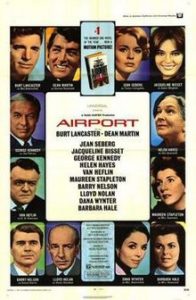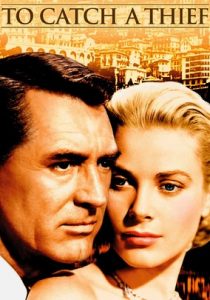Airport-1970
Director George Seaton
Starring Burt Lancaster, Dean Martin, Helen Hayes
Scott’s Review #1,059
Reviewed September 2, 2020
Grade: A
The film that triggered the popular disaster genre that captivated much of 1970’s cinema, Airport (1970) led the pack in innovation and entertained the masses with a large cast of A-list Hollywood stars suffering peril.
What fun!
The blueprint continued with The Poseidon Adventure (1972), Earthquake (1974), and The Towering Inferno (1974). Interestingly, the Airport contains little death, unlike the others who systematically killed off cast members in a reverse whodunit, more like “who gets it”.
It holds up quite well.
Airport is pure bliss for me. An enormous fan of the disaster epic, to begin with, this one satisfies my obsessions with airports and airplanes, adding late 1960s sophistication and style, and a healthy dose of sub-plots.
From a romantic triangle to mental illness to an elderly stowaway named Ada (Helen Hayes), the storylines mesh so that there’s never a dull moment. Events occur amid a twenty-four-hour time, and a busy and snowy Chicago airport is the backdrop.
The cinematic spectacle was based on a little-known novel of the same name written by Arthur Hailey and turned into a screenplay written by George Seaton, who also directs the flick. I love it when a director also writes the dialogue because a better experience often prevails.
Seaton directed Miracle on 34th Street (1947) and a slew of other films, so he knows a thing or two about pulling the heartstrings while offering adventure.
The film was rated “G” so it’s a family-friendly affair.
A cold and snowy winter night in Chicago results in flight delays and a 707 plane getting stuck on the runway in snow and mud. As crews attempt to dig out the plane, Airport manager Mel Bakersfield (Burt Lancaster) is forced to work overtime. His furious wife Cindy (Dana Wynter) demands a divorce. He’s in love with Tanya anyway, a pretty customer relations agent for the airline, Trans Global Airlines, a clever play on Trans World Airlines.
Other characters emerge like a high-spirited chief mechanic (George Kennedy), and married man Vernon, who is a captain of TGA, and having an affair with stewardess Gwen (Jacqueline Bisset), who is pregnant with his child.
The heavy is a mentally disturbed man named D.O. Guerrero (Van Heflin) who is so down on his luck that he desperately crafts a handmade bomb and takes out an insurance policy that his struggling wife Inez (Maureen Stapleton) will receive upon his death.
He boards a plane to Rome with most of the other characters, intent on detonating the bomb, killing himself, and leaving Inez with some financial relief. When she catches on she hurries to the airport, desperate to stop the flight from departing. Of course, things don’t go so well.
The Guerrero’s are my favorite characters. D.O. could have easily been written as a villain, one-note, and dastardly, but he isn’t. He is a sympathetic character, pained and wounded, his troubles are the result of war, and he oozes compassion.
Stapleton is tremendous as Inez, the suffering wife who loves her husband and desperately wants them to have a nice life. The actress gives a gut-wrenching performance that should have won her the Oscar.
Instead, it went to the comic talents of Hayes.
The main appeal of these stories is that the audience slowly gets to know, and falls in love, with the characters. They become like good friends.
The pacing is so good that it’s only the last forty-five minutes of the film where the real action takes place.
Strong characters and rich stories are offered as the buildup, and we know that peril is eventually coming, and indeed it does.
The special effects and the airplane set are fantastic for 1970. The luxury airline with its plush seats and catered meals is on display and the entire length of the plane, and the cockpit, are used heavily.
Characters walk up and down the aisles frequently, so the illusion is a vast and stylish airliner, even though a small set was probably used.
The stewardesses and pilots offer a glimpse of what a luxury it used to be to fly in style without the annoyances of long security lines, check-ins, and constant hassles.
Hell, D.O. casually walks on the plane with a bomb and Ada gets on without a second glance when she claims to be giving a passenger their dropped wallet!
Airport (1970) set the tone for other similar films to follow and successfully mixes sudsy dramatic stories of its characters’ lives with the thrills and plights of those same characters in danger.
I don’t consider it the fluff that many others do, but a satisfying, well-constructed film that still holds up well.
The film was followed by three sequels and heavily spoofed hilariously by the comedy Airplane! (1980).
It bears repeated viewings.
Oscar Nominations: 1 win-Best Picture, Best Supporting Actress-Helen Hayes (won), Maureen Stapleton, Best Screenplay Based on Material from Another Medium, Best Original Score, Best Sound, Best Costume Design, Best Art Direction, Best Cinematography, Best Film Editing


